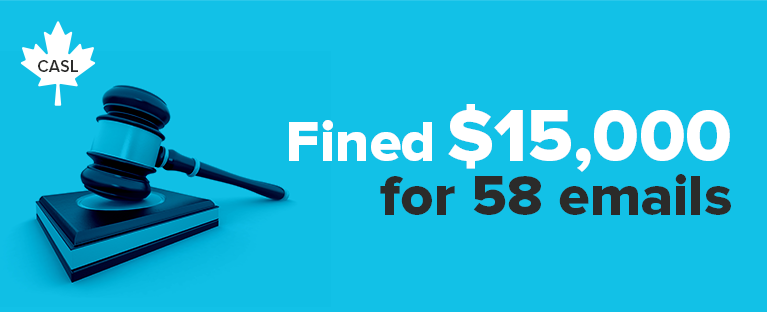On March 9, 2017 the CRTC announced the imposition of a $15,000 fine to Mr. William Rapanos for several violations of the Canadian Anti-Spam Law (CASL).
The CRTC explains,
The Commission imposes an administrative monetary penalty of $15,000 on William Rapanos for 10 violations of section 6 of Canada’s Anti-Spam Legislation. Specifically, Mr. Rapanos sent commercial electronic messages (i) that did not identify the sender, (ii) that did not include information that enables the recipient to readily contact the sender, (iii) without prior consent from the recipients, and (iv) that, in certain cases, did not include a functioning unsubscribe mechanism.
Exhale worry, inhale facts!
Since the fine was issued, several articles have appeared on the subject, such as “CRTC Fines Toronto Area Man $15,000 for Violating Canada’s Anti-Spam Legislation”, or “The CRTC War on Spam Starts Nailing the Little Man” .
Reading these titles could cause panic and even discourage anyone from doing email marketing. And that would be a shame, since email marketing remains one of the most cost-effective and profitable marketing tactics for SMEs! We believe that it’s important to put things in perspective and look at the facts before passing judgement.
Of course it’s important to comply with the CASL when it comes to sending electronic messages for commercial purposes. But we must not panic, and we need to acknowledge that even before this law had taken shape, there were already ethics and good practices put in place.
When doing a simple overview of this case we noticed that the accusations against Mr. Rapanos could have been easily avoided. And that the infractions committed should be in fact “basic email marketing knowledge”.
Let’s dissect the infractions, in order to provide some insight on how this type of scenario can be avoided in the future.
The sender was not properly identified
The first complaint towards Mr. Rapanos is that the email sender (the person who sent the message) was not clearly identified. The name and contact information of the person, company or organization sending the message must be present and easily visible in the email.
If Mr. Rapanos had used a specialized tool such as Cyberimpact, he would not have been able to send the emails without including this information. He would have been protected from himself!
His contact information was not provided
When sending business email correspondence you must provide your mailing address,and either your email address or phone number. Cyberimpact will not only display this information in your email, it will automatically be placed in the right spot to ensure compliance.
A valid unsubscribe link was not always present
When sending emails to your contacts, people should be able to opt-out of your mailing list by clicking on a functioning unsubscribe link. Again, this concept isn’t new. For a long time now, any reputable email marketing solution has had a feature to automate the management of “unsubscribe links”. If you use Cyberimpact, an unsubscribe link is automatically added to the bottom of your email in the official language of your choice, with no extra work to do. This is a beautiful thing!
Sent commercial email messages without first obtaining consent from recipients
We have all received sales emails from people and companies that we’ve never heard of. And if you’re anything like me, you find it annoying. This is exactly how Mr. Rapanos wound up getting reported. He annoyed the wrong people. 50 individuals filed a total of 58 alerts with the Spam Notification Center.
Again, the CASL only adopts existing good practices
For this next point, it’s important to understand the difference between an implied consent and express consent. When the person has given you his / her consent to receive your communications (e.g. someone subscribed to your newsletter on your website), this is an express consent.
When you can demonstrate a business relationship yet they haven’t subscribed, this is an implied consent. The law provides clear guidelines for implied consents. For example, the law states that for a period of two years after a purchase of a good or service, or after the end of a contract; you are allowed to send business email correspondence.
According to the CRTC’s investigation, Mr. Rapanos had no form of consent management, neither express, nor implied.
Cyberimpact makes it easy to manage and obtain consents in many ways. The platform manages and documents consents, sends an automated report of consent expiries,and has a smart consent request module that can easily be included in your campaigns.
Rest assured!
Our goal was not to create panic about the CASL, on the contrary we want to encourage you to use email marketing, allowing you the reach your full marketing potential. Following certain basic rules, and using a tool adapted for the reality of Canadian companies and organizations, will help you avoid potential CASL problems. You will also see better results!
Not using Cyberimpact yet?
